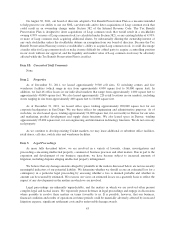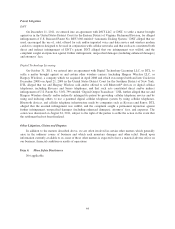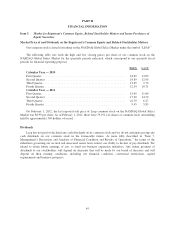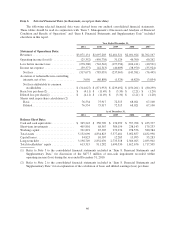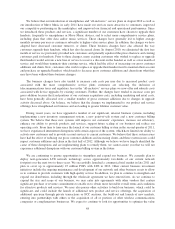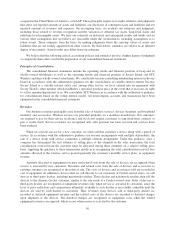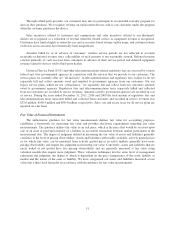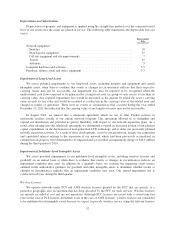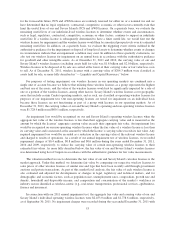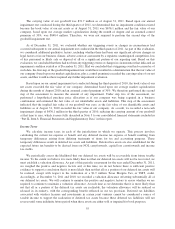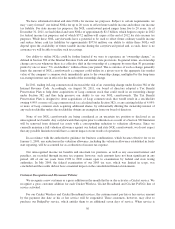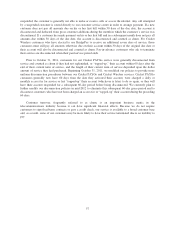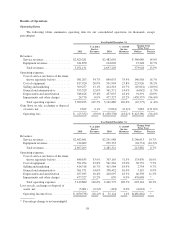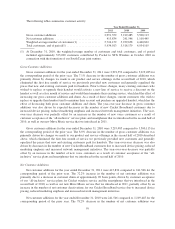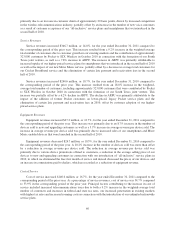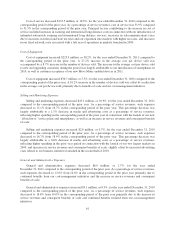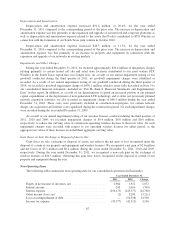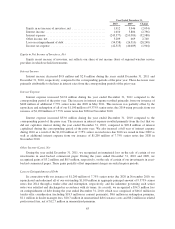Cricket Wireless 2011 Annual Report Download - page 63
Download and view the complete annual report
Please find page 63 of the 2011 Cricket Wireless annual report below. You can navigate through the pages in the report by either clicking on the pages listed below, or by using the keyword search tool below to find specific information within the annual report.for the foreseeable future, PCS and AWS licenses are routinely renewed for either no or a nominal fee and we
have determined that no legal, regulatory, contractual, competitive, economic or other factors currently exist that
limit the useful lives of our and Savary Island’s PCS and AWS licenses. On a quarterly basis, we evaluate the
remaining useful lives of our indefinite-lived wireless licenses to determine whether events and circumstances,
such as legal, regulatory, contractual, competitive, economic or other factors, continue to support an indefinite
useful life. If a wireless license is subsequently determined to have a finite useful life, we would first test the
wireless license for impairment and the wireless license would then be amortized prospectively over its estimated
remaining useful life. In addition, on a quarterly basis, we evaluate the triggering event criteria outlined in the
authoritative guidance for the impairment or disposal of long-lived assets to determine whether events or changes
in circumstances indicate that an impairment condition may exist. In addition to these quarterly evaluations, we
also test our wireless licenses for impairment on an annual basis in accordance with the authoritative guidance
for goodwill and other intangible assets. As of December 31, 2011 and 2010, the carrying value of our and
Savary Island’s wireless licenses (excluding assets held for sale) was $1.8 billion and $2.0 billion, respectively.
Wireless licenses to be disposed of by sale are carried at the lower of their carrying value or fair value less costs
to sell. As of December 31, 2011, wireless licenses with a carrying value of $204.3 million were classified as
assets held for sale, as more fully described in “— Liquidity and Capital Resources,” below.
For purposes of testing impairment, our wireless licenses in our operating markets are combined into a
single unit of account because we believe that utilizing these wireless licenses as a group represents the highest
and best use of the assets, and the value of the wireless licenses would not be significantly impacted by a sale of
one or a portion of the wireless licenses, among other factors. Savary Island’s wireless licenses cover geographic
areas that include certain Cricket operating markets, and as such, are classified as operating wireless licenses for
purposes of our impairment test. Our non-operating licenses are tested for impairment on an individual basis
because these licenses are not functioning as part of a group with licenses in our operating markets. As of
December 31, 2011, the carrying values of our and Savary Island’s operating and non-operating wireless licenses
were $1,728.9 million and $60.1 million, respectively.
An impairment loss would be recognized on our and Savary Island’s operating wireless licenses when the
aggregate fair value of the wireless licenses is less than their aggregate carrying value and is measured as the
amount by which the licenses’ aggregate carrying value exceeds their aggregate fair value. An impairment loss
would be recognized on our non-operating wireless licenses when the fair value of a wireless license is less than
its carrying value and is measured as the amount by which the license’s carrying value exceeds its fair value. Any
required impairment loss would be recorded as a reduction in the carrying value of the relevant wireless license
and charged to results of operations. As a result of our annual impairment test of wireless licenses, we recorded
impairment charges of $0.4 million, $0.8 million and $0.6 million during the years ended December 31, 2011,
2010 and 2009, respectively, to reduce the carrying value of certain non-operating wireless licenses to their
estimated fair values. As more fully described below, the fair value of our and Savary Island’s wireless licenses
was determined using Level 3 inputs in accordance with the authoritative guidance for fair value measurements.
The valuation method we use to determine the fair value of our and Savary Island’s wireless licenses is the
market approach. Under this method, we determine fair value by comparing our respective wireless licenses to
sales prices of other wireless licenses of similar size and type that have been recently sold through government
auctions and private transactions. As part of this market-level analysis, the fair value of each wireless license is
also evaluated and adjusted for developments or changes in legal, regulatory and technical matters, and for
demographic and economic factors, such as population size, unemployment rates, composition, growth rate and
density, household and disposable income, and composition and concentration of the market’s workforce in
industry sectors identified as wireless-centric (e.g., real estate, transportation, professional services, agribusiness,
finance and insurance).
In connection with our 2011 annual impairment test, the aggregate fair value and carrying value of our and
Savary Island’s individual operating wireless licenses were $2,453.0 million and $1,778.6 million, respectively,
as of September 30, 2011. No impairment charges were recorded during the year ended December 31, 2011 with
53


